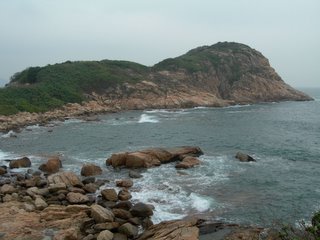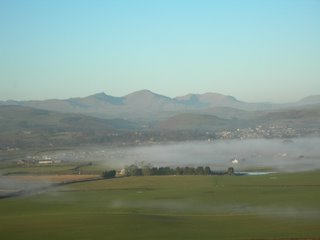Kuala Lumpur, Malaysia. KL is to ramshackle as HK is to slick, and is all the more charming for it. KL is famous for some of the finest traffic jams in the world. I know, I was in one today. But it didn't stop me making the 26 km round trip to Batu Caves on the bus. What nearly finished me was the marginally sub-toxic level of lightweight Malaysian pop music (even worse than HK techno, if that's possible) piped to unbelievably high volumes on board. Luckily I had already bolstered my audio feng shui with a little early Floyd (side one of Ummagumma while lying in bed with a cup of tea. I know how to live).
Batu caves has two main draws - the really huge cave itself with a Hindu temple built in and around it, and (ahem, you guessed it) some CLIMBING! However, the crags, despite being reputedly the best in Malaysia, are strictly local league compared with Thailand. And as the only other punters scuttled off at the merest buzz of a mosquito, I made do with soloing a couple of easy routes for a bit of R&R.
Much cooler were the Hindu temples and the caves themselves, set into a limestone massif a couple of hundred metres high. Lots of statues representing Hindu fables and such, set into the rock. Prominent were the 'Dance of Shiva', and a 'Mango Contest' featuring the popular elephant-headed god Ganesh (a real sweetie).
Your humble 'What Afterlife' (WA) scribe took an audio tour of the exhibits, and is in danger of becoming somewhat-informed. Be assured, however, that WA will strive to maintain a relentlessly low-brow approach to the comparative study of the World's great religions. Incidentally, in HK, WA was surprised to find
Taoist temples that contained
craven images of Gods! WA, who has occasionally flirted with the more intelligible elements of Taoist philosophy, had come across no mention of such gods in his prior studies of foundation texts (The Tao of Pooh is particularly highly recommended). Rather, WA was under the impression that Taoism was a kind of ancient 'yeah, whatever' outlook developed by a secular eccentric named Lao Tzu who, after giving his thoughts to the World, rode off on an elephant never to be seen again. WA now fully appreciates Taoism's position, in corrupted form, as a central Chinese religion that, distinct from the Buddhist and Confucianist ingredients with which it has mingled, adds dashes of superstition, folk-lore and ancestor-worship into the faith mix. However, WA shall mention Taiosm no further, as he is fully aware of Pooh's conviction that 'that which can be described is not the true Tao'.
HK didn't really work for me. For a start, the weather could be described in two words, the second of which is 'freezing'. It was either gloomy, overcast and cold, or gloomy, overcast, cold and raining. Kowloon Peak was often hidden in the mists, which checked a lot of my climbing and walking plans. There is a hot new bouldering guidebook out, but despite hanging out at Wueng Sho, Lamma and Sheck O I didn't see a single other climber. Luckily, these are all nice places with good sport, so it didn't matter too much.
I had planned maybe to go into China proper, but the Chinese Government seemed unmoved by my refusal to pay the massive US$120 visa fee unless they pulled out of Tibet by midnight on Friday and reinstated the Dalai Lama as head of state. Moreover, the imminent Chinese New Year celebrations meant that transport was fully booked up and, worse still, accommodation in HK was chocka. I had to share my windowless shoebox with several unsavoury specimens of insect, and an unpleasant all-permeating odour.
The city itself is OK, especially the harbour ferry crossings and the 8 pm neon lightshow when all the skyscrapers light up. And the goldfish market and the Taoist temples. And a major plus was Lamma Island: no high-rise, a couple of charming harbour villages, and really good for walking. Plus you can get around and out of the city easily and quickly by public transport. The rest is basically like any big Western city, but with 10 times more people to the acre and no room to think.
KL is fully relaxing in comparison, and for the price of a HK shoebox I have a huge luxy room in a 3-star hotel, the kind of place where they have tea-making facilities in your room, and every morning they fold the end of your bog-roll into a point. Like I say, I know how to live!















